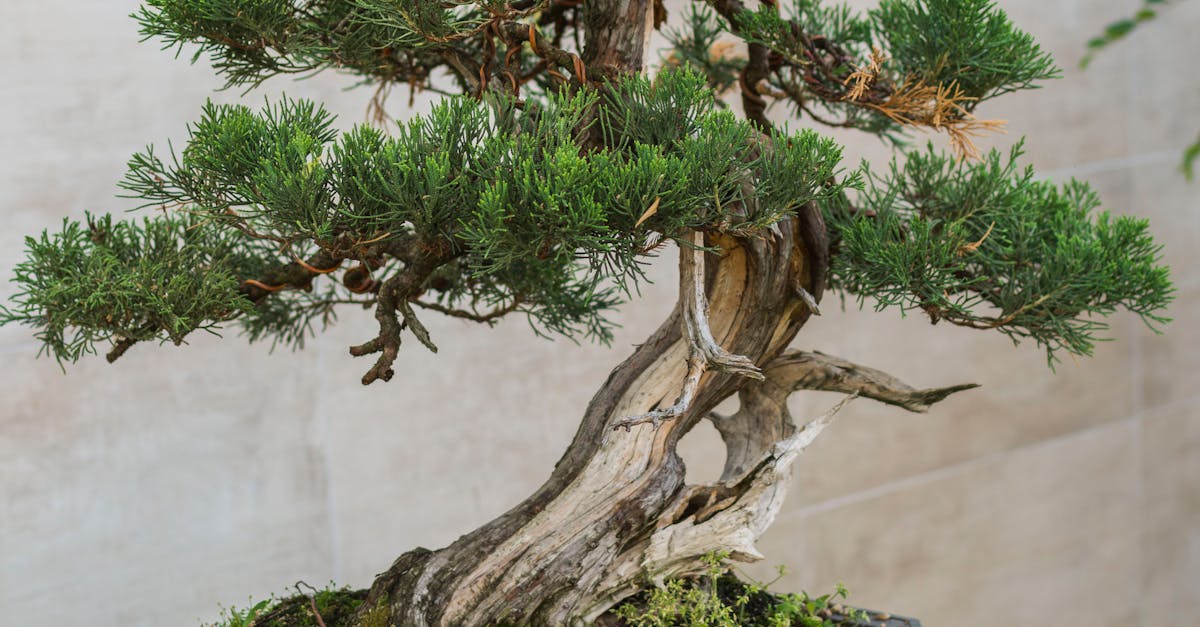Nature’s Sculptor: The Bonsai Masterpieces of Jarek Lenarczyk
In the realm of bonsai art, Jarek Lenarczyk stands as a towering figure, not only in his native Poland but on the global stage. His masterful creations, characterized by their exquisite beauty and profound connection to nature, have earned him widespread recognition and accolades. From his humble beginnings to his rise as a revered bonsai artist, Lenarczyk’s journey has been marked by an unwavering passion for his craft, a deep understanding of traditional Japanese techniques, and a pioneering spirit that has pushed the boundaries of this ancient art form.
As we delve into the world of Jarek Lenarczyk, we will explore the distinctive characteristics of his bonsai style, examining his meticulous tree selection, innovative pruning techniques, and the harmonious pot choices that complement his creations. We will uncover the sources of his inspiration, tracing his artistic evolution from the teachings of nature to the influence of Japanese bonsai traditions and his embrace of contemporary art.
Through an in-depth examination of Lenarczyk’s artistic journey, we will discover the profound impact he has had on the bonsai community. His commitment to preserving and educating future generations ensures that the legacy of this exquisite art form will continue to flourish for years to come.
1. Biography of Jarek Lenarczyk
Jarek Lenarczyk’s journey into the realm of bonsai art began in his early childhood, amidst the picturesque landscapes of Poland. Growing up surrounded by nature, he developed a deep affinity for the intricate beauty and resilience of trees. This early connection laid the foundation for his lifelong passion for bonsai, an art form that celebrates the harmony between nature and human creativity.
As a young man, Lenarczyk encountered the captivating world of bonsai through Japanese anime and manga. Intrigued by the miniature trees’ delicate grace and expressive forms, he embarked on a quest to learn more about this ancient art. He immersed himself in books, studied the techniques of renowned Japanese masters, and sought guidance from experienced bonsai enthusiasts.
With unwavering dedication, Lenarczyk spent countless hours experimenting with different tree species, pruning methods, and pot choices. Through trial and error, he honed his skills, gradually developing a unique style that blended traditional Japanese aesthetics with his own artistic vision. His passion for bonsai grew exponentially, leading him to establish his own nursery, where he cultivated and refined his creations.
2. Characteristics of Lenarczyk’s Bonsai Style
Lenarczyk’s bonsai style is characterized by its distinctive traits, which set his creations apart from the conventional norms of the art form. His approach to tree selection, pruning techniques, and pot choice reflects a deep understanding of nature’s principles and an unwavering commitment to expressing the tree’s inner beauty.
In selecting trees for his bonsai, Lenarczyk seeks specimens with strong, well-defined trunks and branches that exhibit unique character and movement. He favors native Polish species such as pines, junipers, and beeches, appreciating their resilience and adaptability to the local climate. Once a tree is chosen, Lenarczyk meticulously shapes it through pruning, employing a combination of traditional Japanese techniques and his own innovative methods. He believes that pruning should not merely reduce the size of the tree but should also enhance its natural form and reveal its hidden potential.
Lenarczyk’s choice of pots for his bonsai is equally intentional. He carefully considers the size, shape, and color of the pot in relation to the tree’s characteristics. He believes that the pot should complement the tree, providing a harmonious balance and enhancing the overall composition. Lenarczyk often uses handmade pots crafted by skilled artisans, appreciating the unique textures and finishes that add another layer of artistry to his creations.
Tree Selection and Preparation
When selecting trees for his bonsai creations, Jarek Lenarczyk employs a keen eye and a deep understanding of nature’s principles. He favors native Polish species such as pines, junipers, and beeches, valuing their hardiness and resilience to the local climate. Lenarczyk seeks trees with strong, well-defined trunks and branches that exhibit unique character and movement. He believes that these natural attributes provide a solid foundation for shaping and developing the bonsai’s form.
Once a suitable tree is chosen, Lenarczyk carefully prepares it for its transformation into a bonsai. This process begins with root pruning, a crucial step that helps to control the tree’s size and shape while promoting the development of a dense root system. Lenarczyk meticulously trims the roots, removing any damaged or excessively long sections. He then shapes the remaining roots to create a balanced and compact root ball.
After root pruning, Lenarczyk performs initial shaping of the tree’s trunk and branches. Using a combination of pruning techniques, he removes any unnecessary branches and shapes the remaining ones to create a pleasing silhouette. Lenarczyk approaches this stage with great care, as the initial shaping lays the groundwork for the bonsai’s future development.
Pruning Techniques
Jarek Lenarczyk’s pruning techniques play a pivotal role in shaping and refining his bonsai creations. He employs a combination of traditional Japanese methods and his own innovative approaches to achieve the desired tree forms, balance, and overall refinement. Lenarczyk believes that pruning should not merely reduce the size of the tree but should also enhance its natural beauty and reveal its hidden potential.
One of the key pruning techniques used by Lenarczyk is selective branch removal. He carefully examines each branch, assessing its contribution to the overall composition and balance of the tree. Branches that are weak, poorly positioned, or disrupt the flow of the design are removed to create a more harmonious and visually appealing form.
Lenarczyk also employs various cutting techniques to shape the branches and create specific effects. He uses concave cuts to encourage new growth in desired areas and convex cuts to restrain growth. By precisely controlling the angle and placement of each cut, Lenarczyk can influence the direction and density of new枝条s, gradually transforming the tree’s shape over time.
Pot Selection and Composition
In the art of bonsai, the selection of the pot plays a crucial role in complementing the tree and enhancing its overall aesthetic appeal. Jarek Lenarczyk carefully considers the size, shape, color, and texture of the pot in relation to the tree’s characteristics. He believes that the pot should not merely hold the tree but should also contribute to the composition and balance of the bonsai.
Lenarczyk often uses handmade pots crafted by skilled artisans, appreciating the unique textures and finishes that add another layer of artistry to his creations. He favors pots that are simple and understated, allowing the beauty of the tree to take center stage. The color of the pot is also carefully chosen to complement the tree’s foliage and bark.
By skillfully pairing the bonsai with the right pot, Lenarczyk creates a harmonious and visually captivating composition. The pot becomes an integral part of the artwork, enhancing the tree’s natural beauty and inviting the viewer to contemplate the delicate balance between nature and human creativity.
3. Inspirations and Influences
Jarek Lenarczyk’s bonsai creations are a testament to his deep appreciation for nature and his profound understanding of traditional Japanese techniques. He draws inspiration from the organic forms and intricate details found in the natural world, translating them into his bonsai with exceptional skill and sensitivity. Lenarczyk’s keen observation of trees in their natural habitats informs his approach to shaping and styling his bonsai, capturing the essence of their strength, resilience, and beauty.
While deeply rooted in the traditions of Japanese bonsai, Lenarczyk is not bound by its conventions. He embraces contemporary art and design elements, incorporating innovative techniques and materials to create bonsai that are both visually striking and thought-provoking. Lenarczyk’s willingness to experiment and push the boundaries of the art form has earned him recognition as a pioneer in the field of modern bonsai.
By blending traditional and contemporary influences, Lenarczyk creates bonsai that are both timeless and cutting-edge. His work challenges the traditional notions of bonsai aesthetics, inviting viewers to appreciate the beauty of nature in new and unexpected ways.
Nature as a Teacher
For Jarek Lenarczyk, nature is the ultimate teacher. He spends countless hours observing trees in their natural habitats, studying their forms, textures, and growth patterns. This deep connection to nature informs every aspect of his bonsai practice, from tree selection to shaping and styling.
By immersing himself in the natural world, Lenarczyk develops a profound understanding of the principles that govern tree growth. He observes how trees respond to different environmental conditions, how they adapt to their surroundings, and how they interact with other organisms. This knowledge allows him to create bonsai that are not only visually appealing but also botanically accurate.
Lenarczyk’s bonsai reflect the beauty and diversity of nature. His trees exhibit the gnarled trunks and windswept branches of ancient pines that have weathered countless storms. They capture the delicate grace of cherry blossoms in full bloom and the vibrant colors of autumn foliage. Through his bonsai, Lenarczyk invites viewers to appreciate the wonders of the natural world and to contemplate the interconnectedness of all living things.
Japanese Bonsai Traditions
Jarek Lenarczyk holds deep respect for the centuries-old traditions of Japanese bonsai. He has spent years studying the techniques and aesthetics of this ancient art form, and his work reflects a profound understanding of its principles. Lenarczyk believes that the traditional Japanese approach to bonsai provides a solid foundation for creating beautiful and meaningful works of art.
One of the key aspects of Japanese bonsai that Lenarczyk embraces is the focus on minimalism and simplicity. He strives to create bonsai that are elegant and understated, allowing the natural beauty of the tree to take center stage. Lenarczyk also pays close attention to the balance and harmony of his compositions, ensuring that each element contributes to the overall aesthetic appeal of the bonsai.
While Lenarczyk respects the traditions of Japanese bonsai, he is not afraid to innovate and experiment within this framework. He incorporates contemporary design elements and techniques into his work, creating bonsai that are both visually striking and respectful of the art form’s history.
Contemporary Art and Innovation
Jarek Lenarczyk is not content with simply following tradition. He is a true innovator who is constantly pushing the boundaries of bonsai art. Lenarczyk incorporates modern design elements and experimentation into his work, creating bonsai that are both visually striking and thought-provoking.
One of the ways that Lenarczyk innovates is by using non-traditional materials in his bonsai. He has created bonsai using everything from metal and glass to concrete and plastic. These materials allow him to create bonsai that are unique and contemporary, while still respecting the principles of the art form.
Lenarczyk also experiments with new techniques to create bonsai that are more dynamic and expressive. He uses wires and other materials to shape and bend branches in ways that would not be possible with traditional techniques. This allows him to create bonsai that are more sculptural and less naturalistic.
4. Recognition and Legacy
Jarek Lenarczyk’s bonsai have earned him widespread recognition and accolades. He has won numerous awards at prestigious bonsai exhibitions around the world, including the gold medal at the World Bonsai Convention in 2019. Lenarczyk’s work has also been featured in numerous publications and exhibitions, and he is considered one of the leading bonsai artists of his generation.
Beyond his individual achievements, Lenarczyk has also made significant contributions to the bonsai community. He is a founding member of the Polish Bonsai Association and has served as its president for many years. Lenarczyk is also a passionate educator, and he regularly teaches workshops and lectures on bonsai around the world.
Through his teaching and his work, Lenarczyk has inspired countless people to appreciate the art of bonsai. He is a true ambassador for the art form, and his legacy will continue to inspire future generations of bonsai artists.
International Recognition
Jarek Lenarczyk’s bonsai have garnered international recognition and accolades. He has won numerous prestigious awards at bonsai exhibitions around the world, including the gold medal at the World Bonsai Convention in 2019. This award is considered the highest honor in the bonsai world, and it is a testament to Lenarczyk’s exceptional skill and artistry.
In addition to the World Bonsai Convention, Lenarczyk has also won awards at other major bonsai exhibitions, including the European Bonsai Convention and the Japan Bonsai Exhibition. His work has been featured in numerous publications and exhibitions, and he is widely recognized as one of the leading bonsai artists of his generation.
Lenarczyk’s international recognition is a source of pride for Poland and for the bonsai community as a whole. He is a true ambassador for the art form, and his work has helped to raise the profile of bonsai on a global scale.
Exhibitions and Workshops
Jarek Lenarczyk’s bonsai have been showcased at numerous exhibitions around the world. He has exhibited his work at prestigious events such as the World Bonsai Convention, the European Bonsai Convention, and the Japan Bonsai Exhibition. Lenarczyk’s bonsai have also been featured in solo exhibitions at galleries and museums around the world.
In addition to his exhibitions, Lenarczyk also conducts workshops and lectures on bonsai. He teaches students of all levels, from beginners to advanced practitioners. Lenarczyk’s workshops are highly sought-after, and he has taught students from all over the world.
Through his exhibitions and workshops, Lenarczyk shares his knowledge and passion for bonsai with others. He is a generous teacher who is always willing to share his techniques and insights. Lenarczyk’s teaching efforts have helped to spread the art of bonsai to new audiences around the world.
Preservation and Education
Jarek Lenarczyk is deeply committed to preserving the art of bonsai and inspiring future generations. He is a founding member of the Polish Bonsai Association and has served as its president for many years. Lenarczyk is also a passionate educator, and he regularly teaches workshops and lectures on bonsai around the world.
In addition to his teaching efforts, Lenarczyk is also involved in several projects to preserve and promote the art of bonsai. He is the founder of the Bonsai Museum in Poland, which houses a collection of over 100 bonsai trees. Lenarczyk also organizes the annual Polish Bonsai Convention, which brings together bonsai enthusiasts from all over the world.
Through his work with the Polish Bonsai Association, the Bonsai Museum, and the Polish Bonsai Convention, Lenarczyk is helping to ensure that the art of bonsai continues to thrive for generations to come.
5. Conclusion: The Significance of Lenarczyk’s Bonsai
Jarek Lenarczyk is one of the leading bonsai artists of his generation. His work has earned him widespread recognition and accolades, both in Poland and on a global scale. Lenarczyk’s bonsai are unique for their combination of traditional Japanese aesthetics and contemporary design elements. He is a true innovator who is constantly pushing the boundaries of the art form.
Lenarczyk’s bonsai have had a significant impact on the bonsai community. He is a founding member of the Polish Bonsai Association and has served as its president for many years. Lenarczyk is also a passionate educator, and he regularly teaches workshops and lectures on bonsai around the world. Through his teaching and his work, Lenarczyk has inspired countless people to appreciate the art of bonsai.
Lenarczyk’s commitment to preserving and promoting the art of bonsai is evident in his work with the Polish Bonsai Association, the Bonsai Museum, and the Polish Bonsai Convention. He is a true ambassador for bonsai, and his legacy will continue to inspire future generations of bonsai artists.
What is the significance of Jarek Lenarczyk’s bonsai art?
Jarek Lenarczyk’s bonsai art is significant for its unique combination of traditional Japanese aesthetics and contemporary design elements. He is a true innovator who is constantly pushing the boundaries of the art form. Lenarczyk’s bonsai have earned him widespread recognition and accolades, and he is considered one of the leading bonsai artists of his generation.
How has Lenarczyk contributed to the bonsai community?
Lenarczyk has made significant contributions to the bonsai community through his teaching, his work with the Polish Bonsai Association, and his organization of the Polish Bonsai Convention. He is a passionate educator who has inspired countless people to appreciate the art of bonsai. Lenarczyk is also a founding member of the Polish Bonsai Association and has served as its president for many years.
What is Lenarczyk’s approach to bonsai?
Lenarczyk’s approach to bonsai is characterized by his deep respect for traditional Japanese techniques and his willingness to experiment with new ideas. He believes that bonsai is a living art form that should be constantly evolving. Lenarczyk’s bonsai are often praised for their balance, harmony, and attention to detail.






